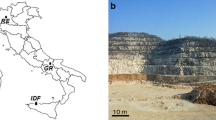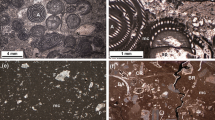Abstract
This paper deals with thermal analyses, burning trials and reactivity tests on 15 carbonate rocks, i.e., pure and impure carbonates, mud-supported and grain-supported limestones, crystalline marbles, and dolomites, used for the production of different lime products in industrial vertical shaft kilns worldwide. In particular, thermogravimetric and differential thermogravimetric analysis (TG–DTG) on massive (80–120 g) fine-grained (< 3.35 mm) samples allowed the extrapolation of the Arrhenius kinetic parameters, i.e., the (apparent) activation energy (Ea) and the pre-exponential or frequency factor (A). Other calcination parameters, i.e., the duration time, starting and ending calcination times and temperatures, and peaks of maximum calcination rate were also extrapolated in order to enhance their relationships with quicklime reactivity. Moreover, thermal analyses (TG–DTG–DTA) were repeated on powders (90 mg) using a more accurate analyzer to compare results. The study is completed by a thorough chemical–physical and mineralogical–petrographic characterization of carbonate rocks and derived burnt products. Results pointed out that medium-to-coarse crystalline materials, i.e., grain-supported limestones, diagenetic dolomites, and granoblastic marbles presented the highest activation energy, burnability and slaking reactivity. Conversely, microcrystalline carbonates with the highest micrite-to-sparite ratio, i.e., mud-supported limestones, and impure carbonates, enriched in quartz, clay minerals, and other subordinated non-carbonate impurities, presented the lowest activation energy, burnability, and slaking reactivity. This study also investigated the effect of BET-specific surface area and real density, depending on specific sintering tendency, on quicklime reactivity. Results from this multidisciplinary research activity put further constraints on carbonate rocks calcination kinetics and their suitability in the lime industry.














Similar content being viewed by others
References
König G, Rellermeyer H, Obst KH. Processes taking place in the dissolution of hard and soft-burnt lime in the slags from the basic oxygen furnaces. Stahl Eisen. 1967;87(18):1071–7.
Obst K-H, Stradtmann J, Ullrich W, König G. Present status and technical advances of steelworks lime for basic oxygen furnaces in Germany. The reaction parameters of lime. ASTM STP. 1970;472:173–92.
Limes RW, Russell RO. Crucible test for lime reactivity in slags. The reaction parameters of lime. ASTM STP. 1970;472:161–72.
Boynton RS. Chemistry and technology of lime and limestone. New York: Wiley; 1982.
Elsen J, Mertens G, Snellings R. Portland cement and other calcareous hydraulic binders: history, production and mineralogy. In: Christidis GE, editor. Advances in the characterization of industrial minerals. EMU notes in mineralogy. London: Mineralogical Society; 2011. p. 441–79.
Oates JAH. Lime and limestone: chemistry and technology, production and uses. Weinhein: Wiley; 1998. p. 139–54.
Georgieva V, Vlaev L, Gyurova K. Non-isothermal degradation kinetics of CaCO3 from different origin. J Chem. 2013. https://doi.org/10.1155/2013/872981.
Tian H, Cai L, Jiang T, et al. Study of kinetic characteristics of limestone decomposition under different atmospheres and heating conditions. J Therm Anal Calorim. 2017. https://doi.org/10.1007/s10973-017-6529-4.
Cheng C, Specth E. Reaction rate coefficients in decomposition of lumpy limestone of different origin. Thermochim Acta. 2006;449:8–15.
Eades JL, Sandberg PA. Characterization of the properties of commercial lime by surface area measurements and scanning electron microscopy. The reaction parameters of lime. ASTM STP. 1970;472:3–24.
McClellan GH, Eades JL. The textural evolution of limestone calcines. The reaction parameters of lime. ASTM STP. 1970;472:209–27.
Borgwardt RH. Calcination kinetics and surface area of dispersed limestone particles. AIChE J. 1985;31:103.
Borgwardt RH, Bruce KR. Effect of specific surface area on the reactivity of CaO with SO2. AlChE J. 1986;32(2):239–46.
Wright G. Effect of impurities on lime reactivity. Ash Grove Cement Company, Rivergate Lime Plant, confidential internal report. 1985. p. 1–41.
Baziotis I, Leontakianakos G, Proyer A, Lee H, Tsimas S. Physico-chemical properties of different carbonate rocks: are they highly enough to control lime reactivity? Int J Chem. 2011. https://doi.org/10.5539/ijc.v3n2p187.
Akande HF, Abdulkareem AS, Kovo AS, Azeez OS, Onifade KR. Application of factorial analysis for quicklime production from limestone. Niger J Technol Res. 2016;11(2):16–25.
Hogewoning S, Wolter A, Schmidt S-O. Dependence of hard burn potential on limestone properties. ZKG Int. 2008;61(6):54–60 (part 1); 61(7):84–93 (part 2).
Lech R, Wodnicka K, Pędzich Z. Effect of the limestone fabric on the fabric development in burnt lime. ZKG Int. 2009;6/7(62):94–101 (part 1); 8(62):63–72 (part 2).
Rodriguez-Navarro C, Ruiz-Agudo E, Luque A, Navarro AB, Ortega-Huertas M. Thermal decomposition of calcite: mechanisms of formation and textural evolution of CaO nanocrystals. Am Mineral. 2009. https://doi.org/10.2138/am.2009.3021.
Soltan AMM. Petrographic modelling of Egyptian limestones for quicklime manufacture. Arab J Geosci. 2009. https://doi.org/10.1007/s12517-009-0095-4.
Soltan AMM, Serry MA-K. Impact of limestone microstructure on calcination activation energy. Adv Appl Ceram. 2011. https://doi.org/10.1179/1743676111Y.0000000042.
Soltan AMM, Kahl W-A, Hazem MM, Wendschuh M, Fischer RX. Thermal microstructural changes of grain-supported limestones. Minerol Petrol. 2011. https://doi.org/10.1007/s00710-011-0151-0.
Soltan AMM, Kahl W-A, Wendschuh M, Hazem MM. Microstructure and reactivity of calcined mud supported limestones. Miner Process Extr Metall. 2012. https://doi.org/10.1179/1743285511Y.0000000024.
Vola G, Sarandrea L. Raw materials characterization for industrial lime manufacturing. ZKG Int. 2013;66(5):62–70.
Alaabed S, Soltan MA, Abdelghany O, Amin BEM, Tokhi ME, Khaleel A, Musalim A. United Arab Emirates limestones: impact of petrography on thermal behaviour. Minerol Petrol. 2014. https://doi.org/10.1007/s00710-014-0329-3.
Vola G, Sarandrea L, Della Porta G, Cavallo A, Jadoul F, Cruciani G. The influence of petrography, mineralogy and chemistry on burnability and reactivity of quicklime produced in Twin Shaft Regenerative (TSR) kilns from Neoarchean limestone (Transvaal Supergroup, South Africa). Minerol Petrol. 2017. https://doi.org/10.1007/s00710-017-0542-y.
Marinoni N, Bernasconi A, Della Porta G, Marchi M, Pavese A. The role of petrography on the thermal decomposition and burnability of limestones used in industrial cement clinker. Minerol Petrol. 2015. https://doi.org/10.1007/s00710-015-0398-y.
Galimberti M, Marinoni N, Della Porta G, Marchi M, Dapiaggi M. Effects of limestone petrography and calcite microstructure on OPC clinker raw meals burnability. Minerol Petrol. 2016. https://doi.org/10.1007/s00710-016-0485-8.
Fuoss RM, Salymer IO, Wilson HS. Evaluation of rate constants from thermogravimetric data. J Polym Sci A. 1964;2:3147–51.
Kiliç Ö. Impact of physical properties and chemical composition of limestone on decomposition activation energy. Asian J Chem. 2013. https://doi.org/10.14233/ajchem.2013.15172.
Emmerich K. Thermal analysis in the characterization and processing of industrial minerals. In: Christidis GE, editor. Advances in the characterization of industrial minerals. EMU notes in mineralogy. London: Mineralogical Society; 2011. p. 129–70.
Bish DL, Howard SA. Quantitative phase analysis using the Rietveld method. J Appl Cryst. 1988;21:86–91.
Young RA. The Rietveld method. International Union of crystallography. Oxford: University Press; 1993.
Dunham RJ. Classification of carbonate rocks according to depositional texture. In: Ham WE, editor. Classification of carbonate rocks, vol. 1. Tulsa: AAPG Mem; 1962. p. 108–21.
Embry AF, Klovan JS. A late Devonian reef tract on northeastern Banks Island. NWT CSPG Bull. 1971;4:730–81.
Sibley DF, Gregg JM. Classification of dolomite rock textures. J Sediment Petrol. 1987;57(6):967–75.
Tucker M, Wright VP. Carbonate sedimentology. 1st ed. Oxford: Blackwell Science; 1990.
Flügel E. Microfacies of carbonate rocks. Analysis, interpretation and application. 2nd ed. Berlin: Springer; 2010.
ISO 9277. Determination of the specific surface area of solids by gas adsorption—BET method. 2010. https://www.iso.org/standard/44941.html. Accessed 1 Oct 2018.
ASTM C25. Standard test methods for chemical analysis of limestone, quicklime, and hydrated lime. ASTM Book Stand. 2017;04(01):28–30.
ASTM C110. Standard test methods for physical testing of quicklime, hydrated lime, and limestone. ASTM Book Stand. 2016;04(01):1–20.
UNI-EN 459-2. Building lime—part 2: tests methods. CEN/TC 51; 2010. p. 1–16.
Schwarzkopf F. Lime burning technology—a manual for lime plant operators. 3rd ed. Van Saun: Svedala Industries Kennedy; 1994.
Doyle CD. Estimating isothermal life from thermogravimetric data. J Appl Polym Sci. 1962;6:639–42.
Ozawa T. A new method of analyzing thermogravimetric data. Bull Chem Soc Jpn. 1965;38:1881–6.
Flynn JH, Wall LA. General treatment of the thermogravimetry of polymers. Phys Chem. 1966;70:487–523.
Commandré J-M, Salvador S, Nzihou A. Reactivity of laboratory and industrial limes. Chem Eng Res Des. 2007. https://doi.org/10.1205/cherd06200.
Wiese F, Wood CJ, Kaplan U. 20 years of event stratigraphy in NW Germany; advances and open questions. Acta Geol Pol. 2004;54(4):639–56.
Towadros EE. Geology of North Africa. London: CRC Press/Balkema; 2012. p. 487–8.
Lentini F, Carbone S. Geologia della Sicilia—geology of sicily. Mem Descr Carta Geol d’Ital. 2014;95:7–414.
Nolan SC, Skelton PW, Clissold BP, Smewing JD. Maastrichtian to early Tertiary stratigraphy and palaeogeography of the Central and Northern Oman. Geol Soc Lond Spec Publ. 1990. https://doi.org/10.1144/GSL.SP.1992.049.01.31.
Martire L, Clari P, Lozar F, Pavia G. The Rosso Ammonitico Veronese (Middle-Upper Jurassic of the Trento Plateau): a proposal of lithostratigraphic ordering and formalization. Riv Ital Paleontol Stratigr. 2006. https://doi.org/10.13130/2039-4942/6338.
Le Blanc J. A revised guide to the Cenozoic surface formations of Qatar, Middle East (excluding the islands). 2017. https://sites.google.com/site/leblancjacques/fossilhome. Accessed 8 June 2018.
Jeppsson L. The lower Wenlock Hangvar Formation—a sequence previously split between the Högklint and Slite beds (Silurian, Gotland, Sweden). GFF. 2008. https://doi.org/10.1080/11035890801301031.
Carmignani L, Meccheri M, Primavori P. Marbles and other ornamental stones from the Apuane Alps (northern Tuscany, Italy). G Geol Appl. 2005. https://doi.org/10.1474/GGA.2005-01.0-23.0023.
Ronchi P, Jadoul F, Ceriani A, Di Giulio A, Scotti P, Ortenzi A, Previde Massara E. Multistage dolomitization and distribution of dolomitized bodies in Early Jurassic carbonate platforms (Southern Alps, Italy). Sedimentology. 2010. https://doi.org/10.1111/j.1365-3091.2010.01174.x.
Scandone P. Note Illustrative della Carta Geologica d’Italia alla scala 1:100.000. Fogli 199 e 210. Potenza e Lauria. Serv Geol d’It. 1971:1–71.
Acknowledgements
Authors gratefully acknowledge helpful peer review of the manuscript by the blind reviewers. We also would like to thank you Prof. Daniele Mazza (PoliTo) for useful suggestions and discussions on kinetics parameters and the FSW method.
Author information
Authors and Affiliations
Corresponding author
Rights and permissions
About this article
Cite this article
Vola, G., Bresciani, P., Rodeghero, E. et al. Impact of rock fabric, thermal behavior, and carbonate decomposition kinetics on quicklime industrial production and slaking reactivity. J Therm Anal Calorim 136, 967–993 (2019). https://doi.org/10.1007/s10973-018-7769-7
Received:
Accepted:
Published:
Issue Date:
DOI: https://doi.org/10.1007/s10973-018-7769-7




